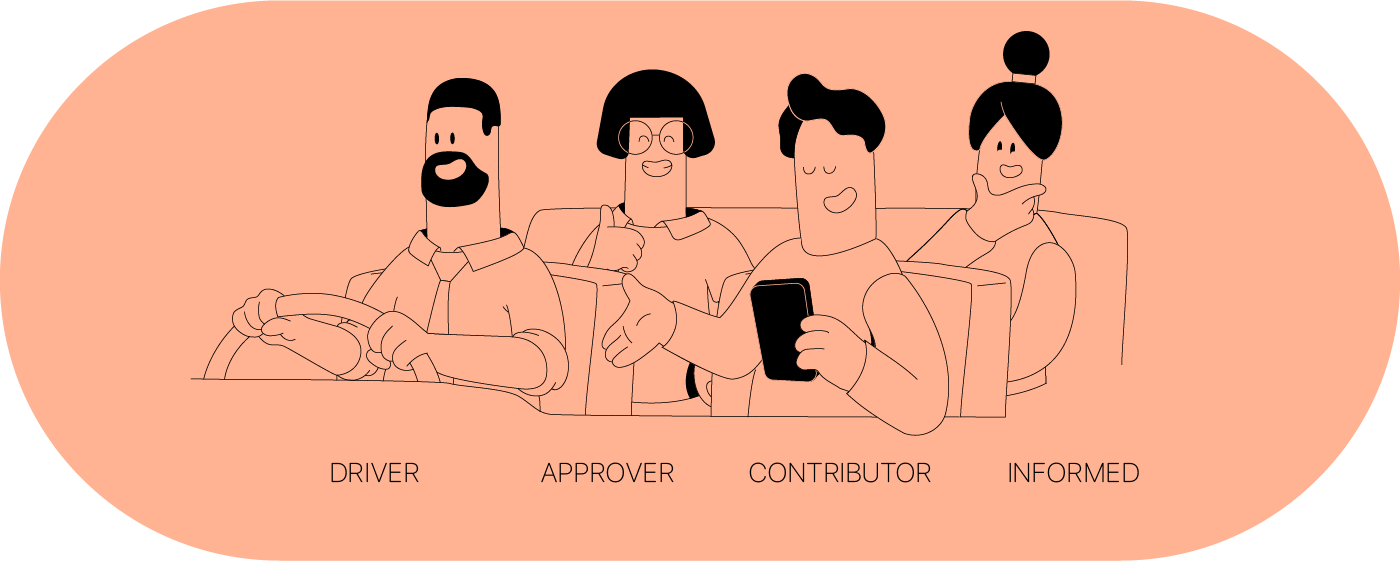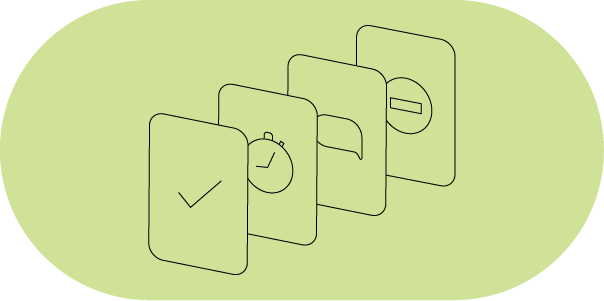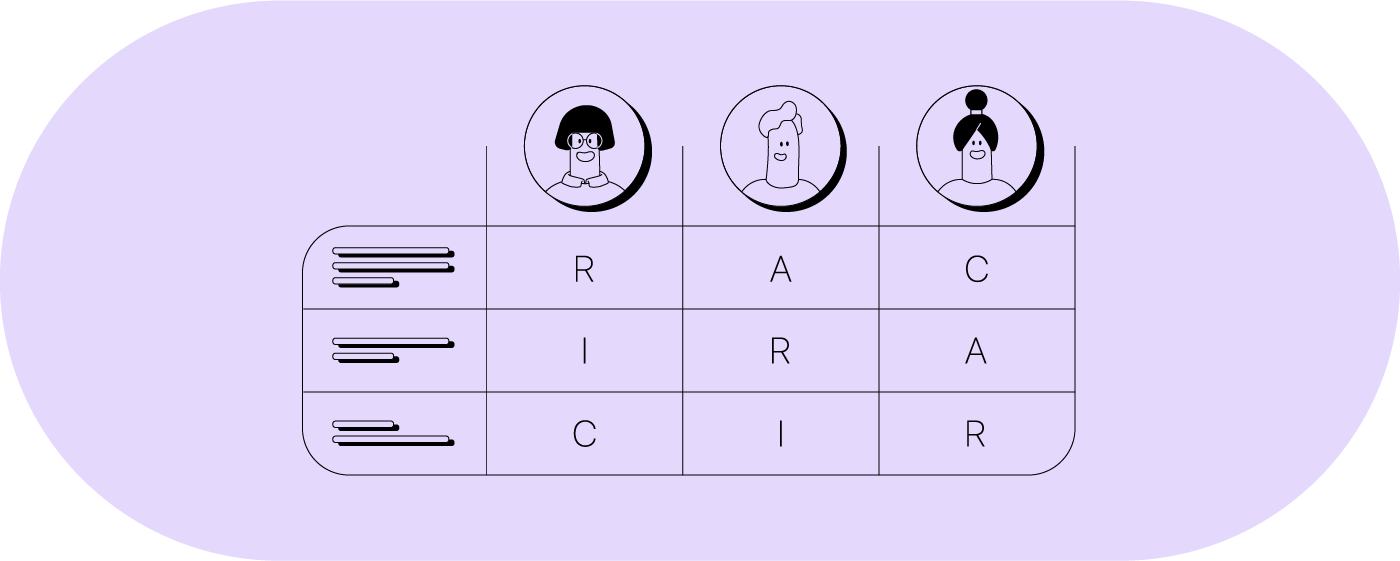The decision-making process is a significant part of any project's lifecycle. It is an ongoing activity that requires the cooperation and involvement of every project stakeholder, from individual stakeholders to organizational leaders.
Uncertainty rules when you don't know who is in charge of what! Many professionals, consultants, managers, and freelancers use the DACI model. In this post, we will explain what the DACI model stands for, how it works, and how it affects your team's decision-making process.
What Is the DACI Framework?
The DACI is a decision-making framework used in project management and leadership circles. It helps organizations to make decisions in a structured and collaborative manner. DACI stands for Driver, Approver, Contributor, and Informed. The DACI framework originated as a RACI variant.
The framework works by assigning roles to team members based on their involvement and authority in decision-making. The Driver is responsible for the project and is the ultimate decision-maker. The Approver is the one who gives final approval for the decision. The Contributors provide input and make suggestions throughout the decision-making process. Lastly, the Informed are kept up-to-date on the decision without being directly involved.
Using the DACI framework can help ensure that all necessary stakeholders are involved in the decision-making process and that decisions are made efficiently and effectively.
Importance of Having a Decision-Making Framework
Having a decision-making framework such as DACI is vital for several reasons:
- Clarity: A decision-making framework brings clarity to the decision-making process by outlining the roles and responsibilities of team members.
- Efficiency: The framework helps streamline the decision-making process, increasing efficiency and faster decision-making.
- Collaboration: The framework encourages collaboration among team members as they work together to make the best decision.
- Consistency: A decision-making framework provides consistency across different decision-making scenarios.
DACI is used for decision-making in project management and leadership circles. It helps ensure everyone involved in decision-making understands their role and responsibilities.
A DACI chart is a visual representation of the decision-making process that outlines the roles and responsibilities of each team member. The chart typically includes the names or roles of those involved and their level of involvement and authority. The DACI chart is often used with project management software to allow collaborators to stay up-to-date and informed throughout the project lifecycle.
Roles and Responsibilities in the DACI

The DACI framework assigns specific roles and responsibilities to team members in the decision-making process. Here's a breakdown of what each role entails:
Driver
The Driver is the primary decision-maker, with ownership and ultimate responsibility for the decision. They manage the process, gather feedback, and make the final decision.
Approver
The Approver is the person who gives final approval for the decision. They are responsible for verifying that the proposed solution aligns with the organization's goals and that any potential risks have been evaluated.
Contributors
Contributors are those individuals who provide input and insights into the decision-making process. They are typically subject-matter experts or stakeholders with relevant knowledge or expertise. The contributors' primary responsibility is to offer recommendations and feedback to the Driver.
Informed
The informed are kept up-to-date on the decision without being directly involved in the process. They may be affected by the decision or responsible for implementing it, but their role is primarily to be informed about what has been decided.
How to use the DACI Framework in project management?
Here are the steps to use the DACI framework effectively in project management:
Identifying Stakeholders
Identify the team members who will be involved in the decision-making process. Assign each team member to a specific DACI role based on their level of involvement and expertise.
Defining Roles and Responsibilities
Clearly define each role and responsibility for the decision-making process. Outlining the roles and responsibilities makes it easier for everyone to understand their part in the decision-making process.
Prioritizing Tasks
Assign tasks and deadlines to each team member based on their role and responsibility. This ensures that everyone knows what needs to be done and when.
Managing Risks
One of the first steps when applying the DACI framework is identifying potential risks that may impact the project. You can do this through risk assessments or brainstorming sessions.
Ensuring Accountability
Once you have defined the roles and responsibilities, clarifying what each job entails is important. Based on these insights, you can create a list of responsibilities for each stakeholder.
DACI Framework and Decision-Making Methods
DACI ensures that everyone involved in decision-making knows their role and responsibilities. It also helps to establish clear lines of communication and accountability. There are many options to choose from when it comes to decision-making methods. Here are a few popular frameworks:
Decision Matrix
The Decision Matrix is a decision-making method that can be used with the DACI framework to help the Driver make a well-informed decision. The Decision Matrix evaluates multiple options against criteria to determine the best choice.

Using the Decision Matrix, the Driver can compare different options based on key factors, which can help them make a more objective and informed decision, which is essential for effective decision-making.
Eisenhower Matrix
Using the Eisenhower Matrix, an Approver can prioritize the tasks that need to be done based on their urgency and importance. This can help the Approver make effective decisions about allocating resources to ensure that the most critical tasks are completed first.

For example, suppose a project is behind schedule and has a looming deadline. In that case, the Approver can use the Eisenhower Matrix to identify which tasks are critical for meeting the deadline and which can be postponed or delegated. The Approver can then allocate resources to ensure the critical tasks are completed first, which can help the project team meet its deadline.
Pareto Principle
Using the Pareto Principle, the Approver can focus on the critical factors that will impact the project most. This can help the Approver make effective decisions about how resources should be allocated to ensure the best outcome for the project.

For example, suppose a project team is experiencing quality issues in their deliverables. The Approver can use the Pareto Principle to identify the critical factors causing the quality issues, such as poor training, lack of resources, or quality control procedures. By focusing on these "vital few" factors, the Approver can allocate resources to address them quickly, improve the quality of the deliverables and decrease the likelihood of project delays or failures.
SMART Goals
By using SMART goals, the Informed role can keep stakeholders informed about the progress of the project or initiative. Regular progress reports should be shared with stakeholders, highlighting how the goals are being achieved and what the next steps are. This type of reporting can help build trust and transparency and ensure stakeholders remain engaged in the process.

Agile Methodology
By using the Collaborator role in the DACI framework, Agile teams can work collaboratively toward achieving their project goals. Collaborative problem-solving and decision-making can ensure everyone's expertise is leveraged to create the best possible solutions. At the same time, open communication and continuous review can keep the project on track and ensure it meets its objectives.

DACI Model Used to Make Decisions in ActiveCollab
Here are the steps on how to use the DACI framework in ActiveCollab management software:
- Define the decision that needs to be made: Before you can use the DACI framework, make sure that everyone involved has a clear understanding of the decision that needs to be made.
- Determine who should be involved: Using the DACI framework, you need to identify who should be involved in the decision-making process. Four roles are typically included in the decision-making process: Driver, Approver, Contributor, and Informed. This information should be put into ActiveCollab and assigned to each person or team.
- Assign each role: Once you have determined who should be involved, you need to assign each role. As previously mentioned, there are four roles, Driver, Approver, Contributor, and Informed.
- Define each role's responsibilities: Each role has specific responsibilities that must be defined. You can add these responsibilities to ActiveCollab as tasks or action items and clearly define who is responsible for each assignment or action item.
- Implement the decision: Once the decision has been made, it needs to be implemented. The Driver is responsible for ensuring the decision is implemented, while the Approver provides final approval. Make sure that all Contributors and the Informed are kept up to date with the decision and its implementation.
DACI vs. RACI
DACI and RACI are two different tools used in project management. Here's a comparison between the two:
DACI (Driver, Approver, Contributor, and Informed) is a tool used to identify different roles and their level of involvement in decision-making. It focuses specifically on a single decision and who should be involved in making that decision. The Driver is accountable for the decision, the Approver can approve or reject it, the Contributor provides input and feedback, and the Informed is kept informed.

On the other hand, RACI (Responsible, Accountable, Consulted, and Informed) is a tool used to identify different roles and their level of involvement in a specific task or deliverable. It helps establish precise levels of responsibility and ensures everyone knows who is responsible for what. The Responsible is the person who completes the assignment, the Accountable is the person who takes ownership and is ultimately responsible for the task, the Consulted are those who provide information or feedback, and the Informed are those who need to be kept informed about the task's progress but can't participate.
While both frameworks use similar acronyms, they differ in their focus and application. DACI is used to identify who should be involved in decision-making, while RACI is used to determine who is responsible for different tasks or deliverables.
Benefits of using DACI
- Boost communication process: Using Daci, a stakeholder or a client can express their concerns or expectations, based on which the project manager can make educated decisions using advice from the Contributor. Through this type of communication, everyone involved can understand the project's purpose and goals.
- Resolve conflict: Let's assume the Approver vetoes a decision, leading to a disagreement within the team. In that case, the other leaders can suggest a solution that complies with every party's interest and move forward with a productive attitude.
- Keep the project on the right track: When you have an appointed person in place, your project will proceed as planned, ensuring your team completes their tasks with clear instructions.
Common mistakes to avoid when using DACI
When using the DACI decision-making framework, there are common mistakes to avoid to ensure effective implementation:
- Not clearly defining the decision that needs to be made.
- Inviting too many people to the decision-making process.
- Not assigning roles and responsibilities.
- Not giving the Driver enough decision-making power.
- Not allowing enough time for contributions.
Tips for effective implementation of the DACI framework include:
- Communicate roles, responsibilities, and expectations ahead of time.
- Create a timeline and stick to it, ensuring enough time for each role to provide contributions.
- Encourage open communication and transparency.
- Make sure that the Driver has the necessary decision-making power.
- Review the decision-making process after the decision has been made to identify key learnings which can be incorporated into future decision-making processes.



